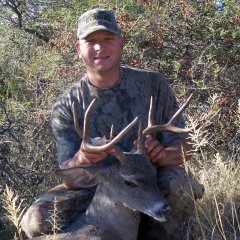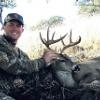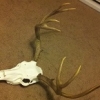

Rembrant
Members-
Content Count
949 -
Joined
-
Last visited
About Rembrant
-
Rank
Advanced Member
- Birthday 11/30/1956
Contact Methods
-
Website URL
http://fabritzart.com
-
ICQ
0
Profile Information
-
Location
Tonto Basin, Arizona
-
Interests
God, Country, Family<br />Ministry, worship music & Christian rock. Wildlife art, landscapes, portraits. Hunting: Coues deer with rifle and bow, archery elk, New Mexico mule deer, was blessed with a big bear once, fishing. Spent many years coaching youth basketball, then they all grew up.
-

Is this the Largest Commissioners Tag Coues Buck ever taken?
Rembrant replied to Coues 'n' Sheep's topic in Rifle hunting for Coues Deer
Magnificant buck! Very high in the Record Book. I can believe this buck had a huge body, but the long nose takes the cake. Any chance this is a hybrid?- 63 replies
-
- A3
- A3 Trophy Hunts
-
(and 1 more)
Tagged with:
-
Nothing wrong with killing big animals or wanting to kill big animals. The problem is in the human ego. The first and original meaning of the word "pride", which is an overly high and undue opinion of one's self. It is a condition that has plagued humanity since the first man. Mike
-
Relax guys. Those are the handicapped people. Mike
-
Bryce Canyon, It is way different. The difference is private vs. public. Foster Ranch is a solid piece of private property where the owner is providing access to the public. The Big Chino is checkerboard private/state (public) land that the leasee is closing to the public. I don't know the breakout of the Chino Ranch; how much is state vs. how much is private. Most Arizona ranches are a private acerage with the house barn etc., and most of the ranch is leased Forest Service/ State Land. The Big Boqillas in unit 10 is checkerboarded State land/ Private (Navajo). In this state, the leasee is leagally able to deny access to anyone even though half of the land (or more) may be public. Usually the acess road goes through the front yard of the ranch and that is where access is denied. Sometimes the private is 10 or 20 acres and the blocked off public land behind it can be thousands of acres. So if its legal, is is right or wrong? I lean toward the idea that it is wrong to deny public land to the public. There's nothing wrong with using your assets in making money. But I wouldn't use your assets to make my money, at least not without paying you for the opportunity. Not everything that is legal and moral is neccesarily right. This is why I think the Game Commission is being bold. What do you think BRYCE CANYON, How would you sort this out? Thanks for asking. Mike
-
The Game Dept. is managing our hunts for “opportunity”; there are a lot of permits all over the place, but that is a different subject. The deal in Chino is that a rancher wants to close a major part of a quality unit that is comprised of a whole bunch of public land, for his own reasons. The screwy thing that reeks of underhandedness is that they announced this closure two days before the perceived release of the antelope draw results. Was the rancher thinking the draw was complete and too late for the Game Dept to change the results? Not my job to know what people are thinking, because I’m not a mind reader, but what this rancher did doesn’t look good. Suspicious people like me wonder why someone would mess with a system that has worked for decades by denying the public access to public lands. People quite often are motivated by money, yet they state they are closing the ranch to pursue solar energy. OK, fine, they are pursuing solar energy – that’s what they say. We’ll take ‘em at their word. I don’t know why the ranch has to be closed for that reason, but that’s what they say. This leaves the Game Dept. with a dilemma. This long standing big game draw system now has a wrench thrown into it at the eleventh hour. Not a good situation considering the quality of this unit, the rarity of an antelope tag, and the passion of the people that want a tag in this special unit. So the Commission votes to issue zero tags for the unit. The rancher doesn’t want antelope hunters on the ranch because of ‘solar energy’ reasons, so the Commission in effect, agrees with the rancher and abolishes the hunt so they can do their solar energy thing. This is a stroke of genius. If the rancher wants no antelope hunters on the ranch (like he says) then the Dept. is bending over backwards to accommodate them, at risk of much criticism from sportsmen. But, if the rancher is underhandedly trying to make a bunch of money by “privatizing” public land for a select few that can afford a high guiding fee, they now have no tags to work with. And people say the commission has no balls. This won’t solve the problem ongoing; there are some good suggestions in this string on how to do this, but I appreciate the Commission stepping up to the plate and playing hardball. Mike
-
So is it right or wrong? If you can't afford to pay to play, and you're not the one making the money, it's wrong; If you can pay the money, or if you are the one making the money it's right. A guy should be able to do with his private land what he chooses, and making money is good. Public lands are public lands to be enjoyed by everyone. I say cut a new road into the public land and bypass the private. But wait a minute, some of the best whitetail country is protected by this very same situation. How should this be sorted out?
-
Yep, a few bone heads shoot stuff up and the rancher closes off tons of public lands because the road goes through his private land. But wait a minute... maybe the rancher is excercising his American free interprise rights. What? Yeah, there's lots of money to be made here. Isn't this some of the very best archery trophy antelope hunting ground in the world? Even though we may be talking about large tracks of state (public) land, one guy can close it off because the road goes through his yard. When all this trophy antelope country is excluded from the public, the one guy can then allow anyone of his choosing to access the land. Enter the big time guide. The big time guide solicites tag holders and finds clients that can pay thousands of dollars to hunt this publically managed, on public land, special trophy area that just became "private". Then the big time guide pays the rancher a big time access fee. And all this can happen without 'Land Owner Tags' like other states do. It's all about money, folks. Pure and simple. Mike
-
All states have their regulations and rules. The Minnesota Game dept had to sort it out just as the Az Game Dept. would have to sort it out. In Az., it would have been determined that the death was not man-caused and the guy who found it would get to keep it. The Game Departments are not the bad guys, folks. Mike
-
Too many comments diss'ing the Game Dept. declaring bad science, mistrust, and ulterior motives. What does a popular vote on a site full of deer baiters prove? Are our motives what is best for the sport in the long run, or about what we can get now? Bad science? Bad motives? Look in the mirror. Besides, y'all are preaching to the choir. I didn't vote - don't see a point. Mike
-
Looks to me that Steve was smiling. Mike
-
On my screensaver. Mike
-
The WT. deer in the northern states are large bodied. The WT. deer in the southern states are smaller. Our desert WT. deer are smaller yet. The size and other characteristics are a result of survival in certain environments. I'm not a biologist, but let me take a guess; The northern deer are larger because they require more size/fat/hide to survive the bitter cold northern winters. The desert deer are smaller because the feed is different, they don't require large size to fight the cold, and being smaller probably helps in the heat and with lack of water. I do believe the Keys deer is it's own subspecies (race). Yet they are all the same species. The whole "subspecies" thing is man's classification of noticable differences in the various races. So, what is a subspecies and what isn't, is subject to what the genious's in the ivory towers want to call them today, or tomorrow. A practical application of all this classification is in the record books. Coues deer can't compete with northern whitetails in the record book, so it's good that the 'book' classifies them differently. In this sense, "subspecies" is important. But they're still the same critter, or species, and always will be. Mike
-
Good thread and good insights in it. Whitetailed deer are whitetailed deer; one species. A Coues deer can breed with an Iowa whitetail, and the result will be a whitetailed deer. Subspecies are a recognition of taxonomical differences brought out of the vast genetic diversity of any particular species by the various invironmental niches they live in. (pretty much what Bill said). I think of "subspecies" as being the same as "race". An indiginous African is black, an indiginous Norwiegan is white; the resulting offspring is a human being. The genetic diversity placed in us and other creatures by our Maker, to ensure our survival by the ability to adapt to various invironments is really quite incredible, and not to be confused with macro evolution. Animals don't change into other animals. That notion is erroneous. Couesfan is barking up the right tree with dwarfism. In human genitics we sometimes get a midget, and we sometimes get a Shaq O'Neil. Way cool deer Couesfan!
-

Messed Up Nation
Rembrant replied to Non-Typical Solutions's topic in Political Discussions related to hunting
"They'll shoot their eye out"!!!! Mike -
300ultramag, Got a little time on your hands? Mike




